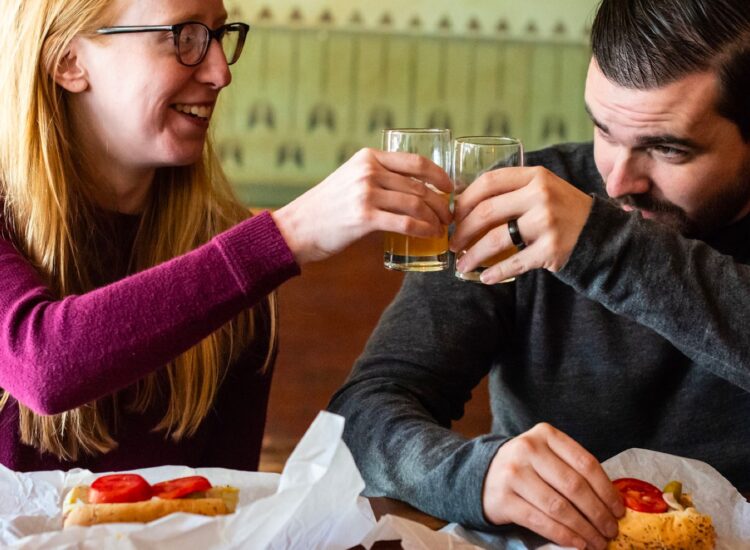Ask yourself: what value does the tour provide your guests? The more value you can add to your tour on top of the main tour product, the more you can legitimately charge for your tour.
As value goes, corporate tours provide more value for those guests than your public tours. Not only are you providing a great, informative, and fun tour, but you’re also facilitating team building, showing clients and executives a good time, and making your client look good in front of their important guests.
Key Insights From Industry Leaders
Catherine Wilhoit, operations manager for Bulldog Tours in Charleston, SC
Catherine shared their pricing model for corporate tours with UpLevel Town Hall participants.
- Book in guest blocks. The minimum number of guests a company can book on a corporate tour is 12. If they fill up that block and book 14 guests, they’ll be charged for a second block of 12, and so forth.
- Use spreadsheets to backwards from your desired margin. If you’re looking to clear 30% (or more — remember, you’re the boss), then start by figuring out all your costs, plugging them into the spreadsheet, and coming up with a per guest price.
- Create a cost sheet. Track anything you regularly spend money on in a handy spreadsheet to help you quickly and easily plug into your pricing sheet. These things can include private dining room fees, guide costs, restaurant costs, etc.
- Tweak pricing for off-season. If your on-season margins are 30% or higher, you may consider dropping those margins during slower months. You can also get a little more lenient with booking minimums and other premiums to help drive business when it’s quiet.
Midgi Moore, owner of Juneau Food Tours in Juneau, AK
Midgi shared some of her pricing tactics, and her strategies for adding value to her tours.
- Start with what you want to make. Price your tour based on how much you need to get out of it.
- High end prices attract high end clients. Clients with deep pockets are willing to spend more for a premium experience.
- Provide value with low-cost add-ons. Offer exclusive merchandise and swag that doesn’t cost you very much but adds a special, detail-oriented element to the experience.
- Offer combo-tours with other tour operators. Partner with other tour operators to create deluxe experiences that only you can facilitate, then charge a premium.
UpLevel’s Ultimate Guide to Pricing Corporate Groups
1) Define One Target Corporate Guest
Stop trying to go after everybody. Be specific. Start small. Pick one person, at one organization, and create a plan to win that one person.
We collect over 75 different data points to fully define a target guest. A few of the key elements to define include:
- Their name
- Their age
- Their job and where they work
- Do they have children?
- How will they first learn about you?
It’s important to define these elements to understand ways you can help.
A lot of times we hear terms like B2B and get this idea that we’re dealing with a business. But even B2B is still about connecting with another person. There’s a human being inside of that business and that is who we want to connect with.

Take the time to define this person. Stop trying to “market” to people and instead look at how you can help another human solve their problem: finding a fun event to do with their team.
2) Know Your “Job”
Coined by the late Professor Clay Christensen from Harvard Business School, your tour’s “job” addresses the emotional motivators that lead someone to book your tour.
In this video, Professor Christensen explains the “job” performed by a milkshake.
By knowing your tour’s “job,” you are better prepared to offer the solution that solves your target guest’s problem.
3) What Works Best For You
The value of your tour and how you price it are fully within your control. What you choose to highlight as value is what determines your pricing just as much as the actual COGS of your tour.
You set whatever rules you want when pricing corporate groups. What’s most important is listening to your One Target Corporate Guest to understand their specific problem. Find out what they’re struggling with and understand what you can do to solve their problem.
Common questions about pricing corporate groups
Do you discount corporate groups?
“I have a minimum price to run a private tour.”
— Alyssa, Bites of Boston
Alyssa maintains a fixed price for her private tours regardless of the size of the group, but groups must consist at least 8 people. There are no discounts available.
“We don’t discount corporate groups. […] We actually charge more.”
— Reneé, Gourmet Food & Wine Tours
After the COVID pandemic closed restaurants, Reneé saw an influx of corporate groups scrambling to find a place for their events. In response, she decided not to discount those bookings but instead raise her prices in order to cover all of the extra work needed before hosting each private group.
Gratuity — how much? 15% or 20%?
“Price per person on one line, tax on the second line, and gratuity on the third.”
— Alyssa, Bites of Boston
Gratuity is a tricky thing, but Alyssa has got it figured out. She always splits the tip right down the middle at 18%, no matter what – even though she can’t quite put her finger on why that’s become her go-to number.
The bigger question became how gratuity is then presented to a corporate group.
For this, Alyssa goes to great lengths to ensure that booking remains a streamlined and transparent process. She ensures all costs are clearly communicated; factoring everything from the individual cost per person, 5% tourism tax as required by Massachusetts law, plus an 18% gratuity fee.
This crystal clear understanding of all tour costs makes it easy for corporate groups to understand exactly how much they’ll be paying.
How do you make the value prop clear, relative to the cost?
“Look at it as problem, solution, then how you do it.”
— Joe Martin, UpLevel Tourism
Knowing your target audience is key for communicating why a corporate group should book with you. Don’t fall into the common mistake of only focusing on what makes up your tour experience. Instead, figure out what resonates most strongly to potential customers and craft an argument that speaks directly to their needs – then they’ll understand exactly why they need to pay top rate!
How do I charge so it’s worth my time?
“it’s not worthwhile unless you can recreate it in the future.”
— Bethia, Columbus Food Adventures
Working in groups of fewer than eight often presents a challenge when it comes to creating a custom experience. To make the process smoother, Bethia’s team has created several pre-crafted packages that are tailored for specific experiences.
Calculation for figuring out your hourly rate.
“Pull out your calculator!”
— Joe Martin, UpLevel Tourism
Many business owners overlook the cost of their own time when it comes to making a profit. To make sure you know your personal financial impact, use this simple formula: How much money you want to make per year, divided by the number of weeks, divided by the number of hours you want to make per week.
This will let you know your hourly rate. This should be included as a part of expenses for any time you spend working on the business.
Grow the corporate tours side of your business.
Decrease your dependency on OTAs and focus on corporate groups to achieve more predictable revenue, higher profit margins, and a larger average order value.


